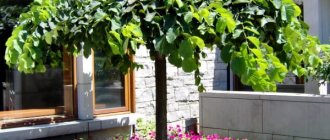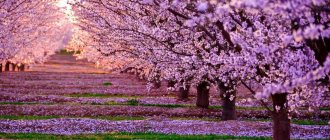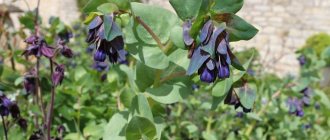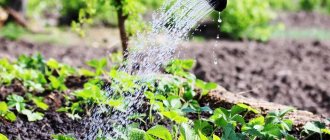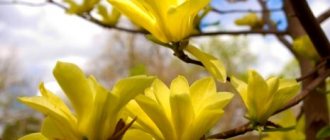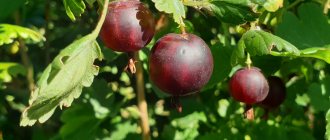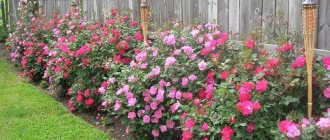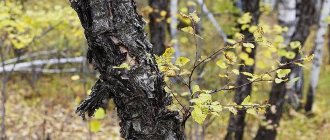The silver pear Pyrus salicifolia was listed in botanical reference books at the end of the 17th century. In its natural habitat it is found in the North Caucasus, the western part of Asia, and Armenia. Willow pear is a perennial deciduous plant; its decorative variety Pendula is used in landscape design. The fruits have no gastronomic value; the tree serves as a rootstock for dessert varieties.
Basic information
The homeland of the pear, which has such an intriguing name, is China.
However, in the vast expanses of Russia, the ornamental pear has not taken root particularly well due to the peculiarities of its care. Important! A medium-sized tree with a cone-shaped crown changes its beautiful green foliage to bright red in the fall.
The decorative climbing pear loves sunny areas. It is not winter-hardy, so it cannot be grown in regions with harsh climates. The crop is represented by perennials, but there are also annual varieties.
Ornamental Chinese pears have many varieties, differing in the color of the green mass, the size of the fruit, and their appearance. The most famous varieties are Willow, Beech Hill, Bradford.
Decorative pear
Growing rules
The willow pear is propagated by cuttings, layering or root shoots. It is often used as a scion for wild crop varieties. The place for the tree should be sunny, without shade, on well-drained soils. Planting of seedlings is carried out in spring or autumn in a hole of 80 cm/1 m, using a fertile substrate. A prerequisite for the landing recess is that the bottom is covered with a drainage pad. The material must be taken at least one year old.
Important! When planting a pear, the root collar is left above the soil level.
Agricultural technology for the loosestrife pear is standard; care is oriented towards the biological characteristics of the crop:
- Watering is moderate; for an adult plant, drying out of the root ball is quite acceptable. The plant is drought-resistant, the root system, completely deepened, provides the tree with the necessary moisture. In the dry season, water the pear 3 times: after flowering, in July and September with a large volume of water. Seedlings up to 2 years old are watered 2 times a month.
- When planting, a fertile mixture is placed at the bottom of the hole; the willow pear has enough nutrients for 3 years. Then the tree is fed every year: at the beginning of the growing season - with compost or superphosphate.
- The crown is formed in the spring, according to the design plan; when creating a trunk, pruning of the lower branches is carried out in the 3rd year of growth, the crown is thinned out in subsequent years. If the crown formation occurs naturally, sanitary pruning is carried out in the spring, frozen and dry branches are removed.
When growing willow pear in a temperate climate, prepare the plant for winter. Abundant watering is carried out, the trunk is wrapped in burlap and the trunk circle is mulched.
Silver goof
The oleaster differs from other plants with silver leaves, first of all, in that its decoration does not lose its silvery flair throughout the entire season, and even in late autumn you have every chance to enjoy their indescribable regal shade. At the beginning of each summer, the shrub is covered with fragrant yellow flowers, and by the 6-8th year of life it even begins to bear fruit with scaly berries.
The silver foliage of this shrub contrasts favorably with other unusual shades, such as yellow or red. Loch goes well with spruce, thuja, juniper and other conifers. The powerful root system of the shrub allows it to be used to strengthen slopes. An ideal plant for a Mediterranean style garden.
Description of culture
Decorative pumpkin
This variety is also called nut or flowering. It represents the Rosaceae family. Trees are perfectly adapted to urban conditions. On the ornamental pear in the spring, soft white, very large flowers bloom, fragrant with a pleasant and strong aroma. A flowering tree resembles a bouquet.
Unlike the flowers, the fruits are very modest, small, dark brown in color. They have no nutritional value, because they are not stored, cannot be preserved, and have a bitter taste. After the leaves fall, pears hang on the branches for a long time, serving as a kind of decoration.
The trees have an amazing and attractive appearance due to the beautiful carved leaves. The graceful crown is a real decoration of parks, squares, and gazebo arches.
Use in landscape design
The willow pear is used for beautifying urban areas, parks, and public gardens. Suitable for adding decorative touches to home gardens. It looks impressive thanks to its voluminous, spherical shape. The photo above shows the white flowers of the willow pear along with long leaves - an original combination. In gardening art, a tree is used as a solitary tree or as an element of a landscape composition. Ornamental willow pear can be used for hedges or edge plantings. Looks great in tandem with coniferous crops.
The largest fruited varieties
Bere Dil is a mid-season, high-yielding variety that has been continuously improving the shape and content of the fruit for two centuries. Young trees grow very quickly, forming a spreading crown of a pyramidal shape and very large (up to 500 g) fruits, which decrease to 270 g with the age of the tree. The juicy melting pulp has a sweet taste with a slight bitterness. Taste qualities significantly depend on growing conditions, fully manifesting themselves with proper care and favorable weather conditions. The variety is susceptible to scab and leaf burns, loves moderate moisture, fertile soils and a mild climate.
Vidnaya is a late-summer pear that forms powerful trees with a pyramidal crown shape and large (up to 540 g) elongated fruits of yellow-orange color. The very tasty and juicy pulp with a slight sourness is wonderfully refreshing, but after picking, the pear cannot be stored for longer than a week. The variety produces consistently high yields, tolerates harsh winters well and is practically disease-free.
Klapp's Favorite (Klapp's Favorite) - this summer self-sterile variety was obtained back in 1860. It is distinguished by a wide-rounded, slightly weeping crown of medium-sized trees. The wonderful sweet and sour taste of the melt-in-the-mouth and very juicy pulp is an excellent addition to the impressive size of the fruit, which can reach a weight of 450 g. The pear is undemanding to the composition of the soil, but on saline and waterlogged soils it grows and bears fruit somewhat worse, and in drought more often damaged by pests. Among the advantages are good frost resistance and regularity of fruiting. However, the variety has weak immunity to scab and can only be stored for a couple of weeks without loss.
Varieties of decorative pears
To decorate recreation areas, different varieties of ornamental pear are used.
Callera Chanticleer
Callera Chanticleer
Decorative beans
This is the most famous variety that came from China. In their homeland, trees grow in forests, groves, and rise above the banks of rivers.
The pear is characterized by rapid growth, adding 40 cm annually. Its crown has a regular conical shape, over the years it turns into a wide pyramidal one. The dark green shiny leaves bloom early and change color from November.
Flowers begin to bloom in April simultaneously with the leaves, but sometimes flowering is somewhat ahead of their appearance. The fruits that appear are quite edible, but the taste is very low.
Important! A young pear may suffer from severe frost, but as it matures it becomes frost-resistant.
Chanticleer is not afraid of polluted air, which is why it is actively planted in cities.
Callery Bradford
This variety comes from the USA. It is distinguished by its large size, with a trunk diameter reaching 9 m and a height of 12 m. The symmetrical pyramidal crown is very dense and compact. Large, oval, dark green leaves with a glossy surface turn orange to purple in autumn.
Bradford blooms abundantly from the end of March. The flowers are very beautiful and quite large. The resulting fruits are inedible. The decorative pear has a short growth period - only up to 25 years.
Callery Bradford
Willow
A very unpretentious plant found in the wild in the Caucasus and Asia. It is also cultivated artificially. The tree easily tolerates dense, moist soils and grows in salty ones. The only whim of the Willow Pear is the absence of gusty cold winds and the love of light.
The willow pear grows very slowly. Its crown resembles a spreading tent. In May, the tree blooms with large flowers collected in corymbs.
The tree has high frost resistance and easily tolerates forced drought. Due to the pear’s ability to withstand gas and dust, it is widely used to green up cities.
Beach Hill
In the wild, this pear can be found in Asia Minor and Europe. A distinctive feature of the variety is its powerful branch structure and narrow pyramidal crown.
Beach Hill
Large bright green leaves tightly fit the branches. In autumn they turn yellow and orange.
The tree blooms in May. The flowers are large and fragrant. The pears themselves taste sour with an unpleasant tartness. Urban conditions do not bother the pear, and it takes root quite well in parks and squares.
The tree is not frost-resistant, and is mostly grown in the southern regions. The plant lives up to 150 years.
Buddleya Davida Silver Anniversary
A spreading shrub with long thin shoots and fragrant flowers collected in panicles. Depending on the variety, they can be cream, pink, lavender, purple, violet or blue. At Silver Anniversary they are white. In addition, buddleia flowers have a bright and rich aroma with notes of honey, which makes it especially attractive to bees and other pollinating insects. This shrub is not very typical for our latitudes, so in the first years it requires increased attention.
Buddleia grows so quickly that if it is not trimmed in a timely manner, it will lose its decorative effect. However, from the point of view of landscape design, this quality cannot be called negative, because it allows you to freely form a crown of any shape.
In Europe, the wild Buddleia Davida feels so comfortable that it can often be found along railway tracks or in vacant lots. And in some US states there is a ban on the sale of plants capable of reproduction. Instead, exclusively sterile cultivars are sold.
The best summer varieties
Chizhovskaya is a late-summer variety that has proven itself well in gardens in the middle zone and more northern regions. The medium-sized tree forms a dense cone-shaped crown. The fruits have a classic shape and medium (up to 140 g) size and are covered with a yellowish-green skin that hides tender, juicy and aromatic pulp with a pleasant sweet and sour taste. The main advantages include excellent winter hardiness and early fruiting.
August dew is a summer variety of low-growing pears that forms a drooping crown of medium density and medium-sized fruits covered with greenish-yellow skin with a slight blush. Fine-grained juicy pulp with a very delicate sour taste. The variety is characterized by low self-fertility, but high frost resistance, productivity and scab resistance.
Cosmic is a tall summer pear with a spreading crown. The medium-sized (up to 110 g) fruits are covered with a dense green skin with a fuzzy blush, hiding a very sweet fine-grained pulp. The variety is characterized by high yield and excellent frost resistance, in addition, it is practically not susceptible to scab.
Krasulya is a very tasty variety that forms neat, medium-sized trees with a rounded crown. Small (up to 90–100 g) oval fruits at consumer ripeness have an attractive appearance due to their shiny dark orange or purple skin. In addition, they are famous for the sweet and delicate taste of the creamy, buttery pulp, which surprises with unusual, spicy notes.
Cultivation of ornamental pear
You can grow a tree from cuttings, from seeds, or by grafting. Willow pear can be propagated by root shoots. For novice gardeners, growing an unusual tree using a small seed may seem problematic, but it is quite possible.
Seed selection
To grow an ornamental plant from a seed, you need to be able to choose and prepare the seed correctly. Growing a seedling in an apartment is not at all difficult if you take into account some nuances.
The seeds are removed from the ripe fruit and poured with hot water. Having washed the required amount of seed in this way, it is dried well and, packed in a sealed bag, put away in the refrigerator until spring.
Soil and site selection
The next stage of preparation is the selection of soil and preparation of a permanent place on the site. Any plant actively develops in fertile soil. Swampy places with expected stagnation of moisture are not suitable for ornamental pear seedlings. Drafts are contraindicated for trees; this should be taken into account when choosing a location.
Cultivation of ornamental pear
This species should be planted in sunny places; light partial shade is acceptable. The optimal soil is sandy loam, at least loamy.
Seed preparation
Take the seeds out of the refrigerator and lay them out to warm to room temperature. Next, the grains are soaked in warm water for 3 days, changing it daily. In the last 24 hours, any of the available growth stimulants are added to the water. After this, the seeds are stratified for better germination.
The mixture is prepared from perlite, river sand, coconut substrate and high-moor silt. It is moistened and pear grains are laid on top. Cover the container with the seed with film and put it in the refrigerator for a period of 80-90 days. In the future, you need to check the humidity level in the container and make sure that the seeds do not rot.
When the seeds germinate, they should be planted in nutritious soil. When 4 pairs of leaves appear, the seedlings dive.
Planting a tree
Planting an ornamental pear is not much different from planting other trees. An annual seedling is planted in the spring so that it is well rooted by winter.
Planting a tree
The planting pit is filled with a fertile mixture and a mineral additive. The root is examined and damage is removed. The seedling is carefully buried, carefully handling the root system. For reliability, install a peg and fix the tree. The tree trunk circle is watered and mulched.
Varieties
The category of decorative pears is quite diverse. Varieties differ in external characteristics, fruit volume and taste characteristics. In addition, the species differ in growing conditions. All varieties have Chinese roots and grow mainly in warm conditions or in areas with a temperate climate. Regardless of the type, ornamental pears are distinguished by abundant and bright flowering. In some cases, trees may differ in the unique color of their foliage, branches or fruits.
Ornamental pears are grown for their external characteristics, since the fruits of such varieties generally have no nutritional value.
Shabby
It grows naturally in southeastern Europe and western Asia. It is found in the Crimea and the Caucasus, where it grows on steep rocky slopes, clearings, and along the edges of beech and oak forests.
The tree can grow up to 6-10 meters in height, less often - up to 15.
It has a branched sparse crown and thorny branches with a felt-pubescent surface. The appearance of the leaves resembles the leaves of the oleaster, which is how the variety got its name. Painted silver, average length 4-9 cm, texture of both sides gray-felt. The fruits are false drupes, up to 2 cm in diameter. Propagated by seeds before winter or spring. The plant responds well to arid soil and air, city conditions, severe frosts (down to −25..−30°C), and is light-loving. Does not require regular pruning - if necessary, diseased or damaged shoots are removed.
The tufted pear is used as a rootstock for cultivated varieties or for landscaping and creating forest shelterbelts.
Caucasian
In the wild, it is distributed in the forests of the Caucasus to the southern territory of Azerbaijan and Armenia. Creates pear groves in clearings of oak and hornbeam forests, along river valleys. The tree grows up to 26 meters in height.
The Caucasian pear is distinguished by a special root system with a pronounced main root.
The bark of the trees is gray and periodically peels off. The branches are prickly, with a large number of white lentils. The leaves are round, less often oblong. Their upper part is shiny and the lower part is dull. The yellow fruits are edible, up to 3 cm in diameter. The pear is quite resistant to drought and does not require additional watering. The tree is most attractive during the flowering period - late April, sometimes early May. Snow-white flowers are grouped into corymbs of 5-8 pieces.
Caucasian pear bears fruit from seeds or cuttings, which are undemanding and can take root in any area.
Willow
The variety is found mainly in Asia and the Caucasus. The willow pear grows in arid open forests of the middle and lower mountain zones. Find out about the Miracle cherry variety here.
The tree grows up to 8-10 meters and has an egg-shaped crown.
Young shoots with white felt pubescence. The leaves are silvery in color and eventually become dark green on top and whitish-fluffy underneath. The variety is propagated by seeds. Small green pears are inedible, but they decorate the tree from summer to winter. Plants are undemanding to soil and care; they take root in salty, dense soil. The appearance of the trees is extremely decorative, so they are planted as hedges.
The willow pear does not tolerate cold winds. The flowering season comes quite early.
Callera Chanticleer
This type of decorative pear is most often found in China. Trees grow at some elevation and along the edges of reservoirs. Over the years, the columnar crown turns into a wide and spreading one. The dark green, glossy leaves turn yellow, orange or bright red in autumn. Also learn how to grow green onions at home in this article.
Small fruits, up to 1 cm in diameter, can be eaten.
The pear begins to bloom in May - numerous light clusters of flowers completely cover the tree. The variety is undemanding to soil and has excellent drought resistance. Callera Chanticleer is used to create green arches and hedges.
Juniper scaly Blue Star
Juniper of this variety grows very slowly, 5-8 cm per year, so it is more suitable than anyone else for use in mini-gardens. Young shoots usually have a turquoise or grayish color, which eventually changes to silver. However, the plant does not lose its effectiveness. The variegation only adds exoticism to its “exterior”.
Like all junipers, Blue Star fits harmoniously into rockeries and alpine slides, as well as multi-level compositions with other evergreens.
Growing from seeds
To grow a healthy ornamental pear tree, before planting you should consider:
- quality and preparedness of seeds;
- soil condition;
- environmental conditions.
Since the ornamental pear is native to China, some parts of Russia will require more effort to grow the tree. Most ornamental varieties are unpretentious to the place of growth and care, however, to increase the chances of survival of seedlings, attention should be paid to the place of planting and care of young trees. Morel will tell you about the characteristics and description of the cherry variety in this material.
Seed selection and preparation
The selection of seeds for growing fruit trees Williams, Talgar beauty and Ornamental pear depends on the purpose of planting. First you should get acquainted with the characteristics of different varieties, and only then choose the material. Growing pear seedlings from seeds indoors requires taking into account some small details - only whole seeds harvested in the fall are suitable for planting. To harvest, you need to take a ripe fruit of the selected variety, cut it lengthwise and extract the seed. The resulting seeds should be placed in a container and filled with hot water. Dry the washed seeds thoroughly and put them in the refrigerator until spring, after placing them in sealed bags.
Soil selection and preparation
Fruit and berry crops take root faster and grow actively in fertile soil enriched with minerals and trace elements. If possible, the place for future planting should be free from drafts, since a strong wind will quickly break a fragile seedling. It is best to choose the southwestern or western side of the site, then the trees will receive enough sunlight. The best soil for ornamental plants is clay or loam. If the substrate is poor, it is necessary to make hills and moderate elevations.
When planting young trees, you should avoid swampy areas and areas with the possibility of moisture stagnation during rains or floods.
Landing
Pre-sprouted seeds can be transplanted into open ground. The planting hole should be prepared in the fall by adding organic fertilizers to the soil. The hole must correspond to the size of the root system of the seedlings so that it can be freely located inside. Before planting directly, the seedling must be carefully inspected and damaged or rotten roots removed. The plant is carefully placed in the hole so as not to harm the root system. For greater stability of the young seedling, you can install a peg nearby. Young trees require good care, especially during the rooting period. Find out about the use of onion peels for gardening here.
Care
A healthy ornamental pear can be grown only by following the rules of care. Excessive watering damages the root system, leading to rot and further death of the tree. The soil around the tree should be evenly moist. Prolonged drought also negatively affects the tree. Therefore, when growing young seedlings, they need to be watered regularly, but moderately. After watering any varieties, including Bergamot and Klappa, the soil should be loosened and mulched - this saturates the soil with oxygen, which activates the growth and development of the plant.
Plantings must be periodically fertilized and fed to stimulate growth.
Spring and autumn pruning will allow you to form the crown of the decorative pear.
Snow pear (Pyrus nivalis)
Snow pear is a medium-sized tree or shrub, the maximum height of which reaches 4 m. The crown is wide and spreading. The buds, leaves and shoots, as well as the inflorescences and ovaries are heavily pubescent, which is why the plant got its name “snowy”. The leaves are oval, elongated, slightly serrated. The flowers are large and white.
The fruits are medium-sized, up to 5 cm in diameter, yellow or green. The pulp is sour and tart, so the fruit is used in processed form. The culture is frost-resistant, but does not tolerate severe frosts. Drought resistance is high. Used as a rootstock. Distributed in Central Asia and the Caucasus.
Spreading plum or cherry plum
Spreading plum , or cherry plum (Prunus cerasifera), Nigra (with black-red leaves and edible dark red small fruits) and Hessei (with unusual bronze-purple leaves with creamy yellowish or pink edging) are also sissies. In addition, stone fruit crops do not like close groundwater.
Spreading plum, or cherry plum (Prunus cerasifera Nigra)
Chinese pear (Pyrus serotina)
The plant's homeland is China, where the tree grows everywhere. The culture is quite popular in Japan, Korea, Israel and other countries. In Russia it is grown in the Primorsky Territory.
Chinese pear is a tree reaching 15 m in height. The shoots are bare, sometimes pubescent, red-brown in color. The buds are oval, oblong, glabrous. The leaves are large, ovate or heart-shaped, fleecy, long-pointed, sharply serrate along the edge.
The fruits are round, up to 3 cm in diameter, brown or yellow in color with light dots. The pulp is white, firm, juicy, sweet.
This fruit is one of the most popular due to its high taste and attractive appearance of the fruit.
Chinese pear is rich in vitamins and minerals. Contains a large amount of potassium needed by the body. It is considered a dietary product. 100g of pulp contains 42 kcal.
The disadvantages of the plant include low winter hardiness, which is significantly lower than that of the Ussuri pear. Fully ripened fruits have a short shelf life. After picking, they begin to turn black and spoil within a week.
Varietal classification of pears
Numerous cultivated varieties of pears can be classified according to several criteria:
- by trunk height (tall, medium-tall, short, dwarf);
- by area of application (decorative and fruit);
- by size of pears (large-fruited, medium-fruited and small-fruited);
- according to the taste of the fruit (sweet, sweet and sour, with a tart aftertaste);
- by crown type (pyramidal, round, columnar);
- by winter hardiness (frost-resistant and heat-loving);
- by pollination method (self-fertile and self-sterile).
However, the most obvious indicator is the ripening time, which is represented by summer, autumn and winter varieties.
- The ripening of summer, or early, varieties in central Russia begins in the last ten days of July, and in more northern regions it shifts for another month. A peculiarity of such varieties is the need for their immediate harvesting, since overripe fruits quickly lose their wonderfully delicate taste and juiciness, turning into unleavened fruits with starchy pulp, and soon they completely fall off. Early pears have a very limited shelf life, not exceeding two to three weeks.
- In September or early October, it is time to harvest autumn, or mid-season, varieties . They differ from summer varieties in their good tolerance of early frosts, but also have limited harvest time, especially in hot summers. Autumn pears are stored much better than their early relatives (up to two months), while acquiring additional taste.
- Late, or winter, pears have the longest shelf life . They are ready for harvesting only in October, so they can grow and ripen without problems only in the southern regions. Harvested fruits, stored at an optimal temperature of 3–5° C, only acquire real taste over time. They can delight you with their aroma and freshness not only during the New Year holidays, but even in March or April.
Common prutnyak
This silvery Mediterranean is especially valued for its late flowering, which begins in late summer (sometimes in the 3rd decade of July) and lasts until mid-autumn.
Common prutnyak, photo by the author
Vitex agnus-castus is a deciduous shrub 2-8 m high and wide, with a tart aroma, palmately dissected 5-7-lobed leaves with pointed tips. Tubular lilac (blue, light pink) flowers are collected in apical panicles 13-18 cm long.
Common prutnyak, photo by the author. Prutnyak in bonsai culture. Photo from the site s-media-cache-ak0.pinimg.com
It is quite frost-resistant, withstands up to -17.8 ° C without damage. It is better to plant in sunny places protected from the winds (for example, near a wall), on well-drained soils. Propagated by seeds at +6. +12 °C in autumn or spring; semi-lignified cuttings - in summer.
But my story would be incomplete if I did not mention the exotic woody leaves with a bluish tint:
- yucca (Yucca);
- agave;
- nolinah (Nolina);
- Beschorneria and other rosettes.
Yucca, photo by the author
They are good in southern dachas, and above all in rockeries.
Agave americana - charming and terrifying bluish exotic, photo by the author
Undoubtedly, these are the accents of the compositions.
Accent, photo by the author
They bring southern charm to our dachas, and it’s wonderful!
And in conclusion, a traditional question: what silvery trees grow on your site?
Willow pear (lat. Pyrussalicifolia) belongs to plants of the genus Pear, family Rosaceae. It was first described in 1776 by the German naturalist Peter Semyon Pallas. The tree gives an average growth of up to 20 cm per year. It is used in furniture production, for decorating gardening areas, and also as a rootstock for cultivated varieties of pear.
Caucasian pear (Pyrus caucasica)
The plant is widespread in the Caucasus. It is a tall tree, reaching 25 m. It has a spreading, pyramidal crown of medium density with smooth, gray bark. The branches are prickly, arched, brown. The shoots are dark burgundy. The buds are conical, smooth, slightly bent.
The leaves are wide, round or oval, up to 4 cm long, short-pointed, dark green, smooth. They are held on a long petiole. The flowers are white, collected in corymbs, with rounded petals.
The fruits are lumpy, pear-shaped, greenish-yellow. The peduncle is medium, thick, curved. The pulp is oily, juicy, tender, sweet, aromatic. Contains sugars, titratable acids, ascorbic acid. Fruit ripening begins at the end of August. The duration of their storage is 1-1.5 months. Pears picked a week before full ripening tolerate transportation well. The Caucasian pear is self-sterile and requires pollinator varieties “Klappa”, “Williams”, “Red-cheeked”, “Korsunskaya”. Fruiting begins at the age of 7-8 years. Productivity is high. The fruits are dried and processed and consumed fresh.
Description of the willow pear
The pear grows in the form of a tree, less often a shrub. The central trunk reaches 8-10 m. The crown is wide, spreading, dense, up to 4 m in diameter. The branches are thin, arched, giving the tree a weeping shape; without crown correction, the lower branches touch the soil surface. But more often this variety is grown as a standard variety.
The willow pear grows quickly, adding up to 25 cm within 6 months of the growing season. The tree is frost-resistant, can withstand temperatures down to -370 C. It tolerates dry summers more easily than cold, damp climates, and does not grow on wet soils. The willow pear is a drought-resistant variety; it does not stop growing without watering and does not lose its decorative properties.
General characteristics of the appearance of the willow pear:
- Perennial branches of medium thickness, drooping, dark gray with a brown tint, rough bark with small short furrows and sparsely located thorns.
- Young shoots are silvery and densely pubescent.
- The leaves are long, narrowly lanceolate - up to 7 cm, width - 1.5 cm. The surface is dark green with a slight edge, the lower part of the leaf blade is light gray. The leaves are located on the upper part of the shoots; up to 8 leaf blades are attached to one short petiole. They resemble willow in shape and arrangement.
- The flowers are white, five-petaled, with a delicate aroma, form corymbose inflorescences, collected in 6-8 pieces. The pear tree blooms before the leaves appear, in mid-April.
- The shape of the fruit is round, often pear-shaped, the formation of ovaries is abundant. The fruits are arranged in pairs, small in diameter - 2.5 cm. Unripe ones are light yellow, in the stage of biological ripeness they are closer to light brown, the surface is slightly bumpy with small dark dots, they do not fall off until frost. The taste is bitter, tart, and the fruits of the willow pear have no nutritional value.
- The root system is deep, branched, and produces numerous basal shoots during the growing season.
An ornamental variety - the willow pear Pendula - differs from the classic variety in growth; the tree is rarely more than 5.5 m. The crown has a clearly defined weeping shape. The leaves are light ash in color from emergence until autumn. A synonym for the name of the decorative form is silvery weeping pear.
Gray wing hazel
Luxurious silvery shrub native to China and Japan.
Gray wing-hazel, photo by the author. He’s on the lawn, photo by the author
Gray wing-hazel, or gray karyopteris (Caryopteris incana) is a dense cushion-shaped deciduous shrub 0.5–1.2 m high, 1–1.5 m wide. Leaves up to 7 cm long are fragrant, oval, gray-green, jagged along the edge. Small light violet-blue (sometimes white) flowers are collected in rounded complex umbels; bloom in autumn in the axils of the upper leaves.
Another silvery beauty, C. cladonensis, .
Karyopteris cladonensis, photo by the author
Both are grown in light, moderately fertile, well-drained soils in sunny areas. In the southern districts they can withstand -15 °C, in more northern regions they need shelter. In central Russia they are grown as herbaceous perennials (with shoots pruned to the base and mulched for the winter). It is better to plant them against a south-facing wall.
Propagated:
- in the fall - seeds in greenhouses or containers;
- in late spring - semi-lignified cuttings;
- at the beginning of summer - with green cuttings (they take root better when using a moisture-intensive, slightly clayey substrate).
In addition, suckers sport beautiful silvery leaves.
Silver goof. Photo from the site uraldachnik.ru
But you will get to know them better in my next articles.
Eleven angustifolia. Photo from kurdistantribune.com
I won’t talk about the European olive just yet, because I want to present it in a new form and from a rather unexpected perspective.
European olive, photo by the author
But I will introduce you to the common twig right now.
What kind of tree is a pear?
The pear genus belongs to the Rosaceae family. Most of its representatives, both cultivated and wild, are deciduous trees that can grow up to 25 meters in height and live up to 150, and sometimes up to 200 years. The pear is famous not only for its delicious fruits, but also for its remarkably beautiful amber wood, which is easy to process.
Wild varieties have been common since ancient times in Central Asian regions and most European countries, but their fruits are small and completely inedible. However, thanks to the efforts of breeders, a huge number of zoned varieties have now been obtained that produce tasty and abundant harvests throughout almost the entire territory of Eurasia, with the exception of the driest or too cold areas.
The pear feels best on light soils that are rich in humus and have neutral acidity. But acidic and waterlogged soils are not the best place to plant this demanding tree. Even if it takes root in such conditions, it will be very reluctant to bear fruit.
Willow pear "Pendula"
The loosestrife pear has a weeping form called "Pendula", which is a tree with thin, drooping branches. The height of the tree depends on the height of the rootstock trunk. The leaves of the willow pear "Pendula" are lanceolate, silvery above, pubescent below, up to 8 cm long, up to 1.5 cm wide. Thorns and shoots of one and two years old are also pubescent. The flowers are white, collected in umbrella inflorescences. The fruit is round, small, up to 2 cm in length. It is supported by a short stalk. Inedible.
Pendula pear is not picky about soil and is frost and drought resistant. It easily tolerates pruning, thanks to which the crown can be given different architectural shapes.
The culture is propagated by grafting and cuttings. The grafted plant grows tall at a young age, then acquires a spreading shape. Used for decorative purposes. Planted singly and in group plantings.
Landing
The Willow pear is unpretentious and takes root in any conditions without any problems. Recommendations for planting seedlings can be found in the articles selected below.
How to plant a pear tree correctly
At what distance to plant pears?
How to choose pear seedlings
How to replant a pear
Pests and diseases
If the growing conditions are met, the willow pear rarely gets sick. But, like any representative of the species, it can be affected by the following infection:
- Leaf curl. The disease affects young leaves, they stop growing, curl, turn brown and fall off. To prevent the development of the disease, the pear is treated with products containing copper or iron before the buds begin to grow.
- Brown spot. A fungal infection affects the leaves, manifests itself as dark spots on the surface, then the areas increase and cover the leaf plate completely. To eliminate the fungus, use “Topaz” or “Fundazol”.
- Bacterial burn. The infection progresses with high soil and air humidity. The tree is completely affected, the flowers change color to dark yellow, the branches and fruits turn black, the leaves dry out. Bacterial contamination is eliminated with copper sulfate or Bordeaux mixture, problem areas are cut off and removed from the area.
Among the pests that pose a threat to the willow pear are:
- gall mites, get rid of them with “Trichlormetafos”, “Karbofos”;
- pear worm, eliminate the pest with “Decis” or “Agrovertin”;
- pear codling moth, destroy caterpillars with “Fufanon”.
As a preventive measure, the crown is treated with copper sulfate in the spring before the sap flows. Whiten the trunk with lime or water-based paint.
Ussuri pear (Pyrus ussuriensis): description and photo
The first description of the Ussuri pear was compiled in 1857 by the Russian botanist K.I. Maksimovich. This species is a wild fruit tree, reaching 10-15 m. It has a straight trunk covered with black or dark gray bark. The crown is thick, dense, spreading, reminiscent of a tent. The root system of the plant is quite powerful. The shoots are yellowish-gray, glabrous. The leaves are oval, with an elongated apex, dense, finely serrated along the edges, alternate, shiny dark green above, matte and light below. In autumn they turn red-purple.
The flowers are large, about 4 cm in diameter, white with a pleasant aroma, collected in inflorescences of 5-10 pieces. Flowering begins before the leaves bloom and lasts 5-10 days. Pollination of flowers is carried out using pollen from a neighboring tree. Fruiting begins at 9-11 years of age.
Fruit ripening occurs at the end of August - beginning of September. The fruits have different shapes, can be round or oblong pear-shaped, gray-green or yellow, weighing up to 100 g. Ussuri pear is not consumed fresh, since its pulp tastes quite sour and tart.
The fruits go for processing. Kvass, fruit tea, compote, jam, and jam are made from them. Wild pear jam has a strong, pleasant aroma. The average harvest from one tree is 30-40 kg per year.
The wild Ussuri pear is found in the deciduous forests of Northeast Asia, China, Korea, and grows in Primorye and the Amur region. It settles on small islands, along rivers, on the edges of forests, gentle slopes and in places where there is no strong shading, since this individual is quite light-loving. Propagated by seeds, layering, root suckers. It has high winter hardiness and good decorative qualities. Used for urban greening. Easily adapts to urban conditions and effectively reduces noise. It is valuable as a frost-resistant rootstock and as a source material for breeding new varieties.
In the photo, the Ussuri pear is shown during the flowering period.
Sources used:
- https://7ogorod.ru/plodovye-derevya/dekorativnaa-grusa.html
- https://agrognom.ru/fruits/pear/dekorativnye-derevya-i-kustarniki-ivolistnaya-grusha.html
- https://ogorod.ahuman.ru/grusha-loholistnaja/
- https://poferme.com/sad/derevya/grushi/sort-gr/dekorativnaya.html
- https://www.udec.ru/derevo/grusha-vidy.php
Apricot Manchurian
Manchurian apricot also grows well in our area . In spring, before the leaves bloom, pale pink flowers appear on the branches. Cross-pollination may even produce fruit. This tree undoubtedly deserves to decorate the spring landscapes of the middle zone.
Apricot (Apricot, Armeniaca vulgaris)
